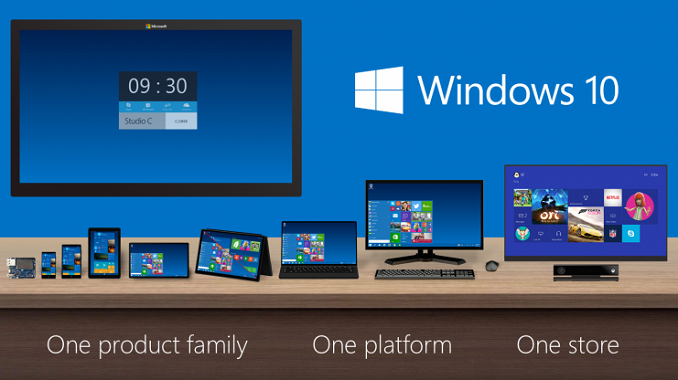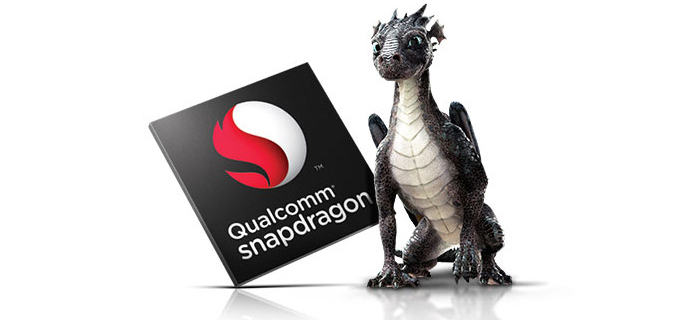Microsoft and Qualcomm Collaborate to Bring Windows 10 & x86 Emulation to Snapdragon Processors
by Matt Humrick & Brett Howse on December 7, 2016 10:00 PM EST- Posted in
- Microsoft
- Snapdragon
- Qualcomm
- Windows 10

Today at Microsoft’s WinHEC event in Shenzhen, China, the company announced that it’s working with Qualcomm to bring the full Windows 10 experience to future devices powered by Snapdragon processors. Terry Myerson, executive vice president of the Windows and Devices Group at Microsoft, is “excited to bring Windows 10 to the ARM ecosystem” and looks forward to bringing “Windows 10 to life with a range of thin, light, power-efficient and always-connected devices,” which may include anything from smartphones to tablets to ultraportable laptops to servers. These new Snapdragon-powered devices should support all things Microsoft, including Microsoft Office, Windows Hello, Windows Pen, and the Edge browser, alongside third-party Universal Windows Platform (UWP) apps and, most interestingly, x86 (32-bit) Win32 apps. They should even be able to play Crysis 2.
This announcement fits nicely with Microsoft’s “Windows Everywhere” doctrine and should come as no surprise. It’s not even the first time we’ve seen Windows running on ARM processors. Microsoft’s failed Windows RT operating system was a modified version of Windows 8 that targeted the ARMv7-A 32-bit architecture. It grew from Microsoft’s MinWin effort to make Windows more modular by reorganizing the operating system and cleaning up API dependencies.
This work first surfaced in Windows Server 2008, which could be installed with a stripped-down, command-line only interface that did not include components such as Internet Explorer that were not necessary for specific server roles. Windows RT also leveraged the newer Windows Runtime (WinRT) API that offered several new features such as digitally signed app packages distributed through the centralized Windows Store and the ability to run apps within a sandbox. It also made it easier for software developers to target multiple CPU architectures. However, Microsoft’s rework of Windows was not yet complete, leaving Windows RT with a bunch of legacy Win32 code that went unused. It also could not run Win32 desktop apps, severely limiting the number of available apps to only those using WinRT and distributed through the Windows Store.
MinWin and its derivatives have continued to evolve over the past few years after getting a major boost in 2013 when Microsoft reorganized its disparate software platforms into the singular Operating Systems Engineering Group. The end result is Windows 10, a modular OS that can run on anything from low-powered IoT devices to high-performing workstations and servers. Its foundation is OneCore, MinWin’s direct descendant, that includes only the operating system kernel and components essential for any hardware platform. OneCore UAP (Universal App Platform) is another major module for Windows 10 whose groundwork was laid during the creation of Windows Phone and Windows RT. It provides support for Universal Windows Apps and Drivers, along with more advanced features such as the Edge browser and DirectX. On top of these modules, Microsoft can add modules that target specific device families (desktop, mobile, Xbox, HoloLens, etc.) that provide specialized features and shells.
Also included in OneCore UAP is Universal Windows Platform (UWP). An extension of the WinRT API used in Windows 8, it allows developers to create universal apps that are CPU architecture agnostic and can run on multiple devices, seamlessly adapting their user interface and input methods to the hardware they’re running on. With UWP, the architecutre independence is achieved by having pre-compiled versions for each platform available from the Store, which will then download and install the correct version for the individual device. The major change with today's announcement over Windows RT and UWP is that x86 apps will be able to run on Qualcomm's ARM-based SoCs, along with support for all of the peripherals that are already supported with Windows 10. This alone is a huge change from Windows RT, which would only work with a small subset of peripherals.
Microsoft is also focusing on having these devices always connected through cellular, which is something that is not available for many PCs at the moment. Support will be available for eSIM to avoid having to find room in a cramped design to accomodate a physical SIM, and Microsoft is going so far as to call these "cellular PCs" meaning they are expecting broad support for this class of computer, rather than the handful available now with cellular connectivity.
The ability to run x86 Win32 apps on ARM will come through emulation, and to demonstrate the performance Microsoft has released a video of an ARM PC running Photoshop.
This of course raises several questions, few-if-any of which Microsoft is willing to answer. Intel has long exerted strong control over the x86 ISA, limiting or outright preventing competitors like NVIDIA from implementing x86 support. So how Microsoft and Qualcomm are able to (for lack of a better way to put it) get away with this is a big question. Certainly there's no indication right now that this has Intel's formal blessing.
The key points here are that this is a form of software emulation - Microsoft even calls it as much - and that only 32-bit x86 support is being offered. On the former, this means that there's no hardware execution of x86 instructions taking place - though Microsoft and Qualcomm are certainly lining up instructions as best they can - which avoids many of the obvious patent pitfalls of doing x86 in hardware, and puts it in the same category as other x86 emulation mechanisms like DOSBox and QEMU. Meanwhile only supporting 32-bit x86 code further rolls back the clock, as the most important of those instructions are by now quite old, x86 having made the jump to 64-bit x86-64 back in 2003. So it may very well be that it's easier to avoid any potential legal issues by sticking with 32-bit code, though that's supposition on our part. In any case it will be interesting to see what instructions Microsoft's emulator supports, and whether newer instructions and instruction set extensions (e.g SSE2) are supported in some fashion.
Of course, the performance of this solution remains to be seen. x86 is not easy or cheap to emulate, and an "emulator" as opposed to a Denver-like instruction translation makes that all the harder. On the other hand, while maximizing x86 compatibility is great for Microsoft and Qualcomm, what they really need x86 for is legacy applications, which broadly speaking aren't performance-critical. So while x86 on a phone/tablet ARM SoC may not be fast, it need only be "good enough."
In any case, Windows 10’s ability to scale and adapt to essentially any hardware platform is a remarkable feat of engineering, and it’s what makes today’s joint announcement with Qualcomm possible. The first devices with Snapdragon SoCs running the full Windows 10 experience should be available in the second half of 2017.
It will be interesting to see what shape these devices take and which companies produce them. Some new lower-cost, full-featured Windows 10 tablets would be a welcome addition, and Qualcomm has its eyes on the low-powered server market too with its Centriq product family. A Windows 10 smartphone with a Snapdragon SoC is also likely, but with Windows Phone 8 holding less than 1% global market share, according to Gartner, Microsoft is essentially starting from scratch. Will the benefits of universal apps be enough to lure software developers and users of other Windows products away from Android and iOS? Can Windows 10 reestablish Microsoft as a major player in the smartphone market, or is the hole it has dug over the past decade too deep?












117 Comments
View All Comments
Gunbuster - Monday, December 12, 2016 - link
Atom is slow, try using one for a while. It will drive you insane. (Cherry Trail)Michael Bay - Friday, December 9, 2016 - link
They have had this portable core thing for a while now. But you can`t realistically expect them to leave UI to the third parties, it will only lead to the epic clusterfuck everyone can see on Android right now. Could get better designers though.andrewaggb - Thursday, December 8, 2016 - link
This is what surface rt should have been... Full windows 10 on ARM with x86 emulation when necessary. Sounds good.I'm curious how many legacy apps will actually work. DX9? DX10-11? ActiveX and COM? Maybe they've figured all that out... if so then this is pretty cool. If not I suspect it will frustrate people when their app doesn't work.
inighthawki - Thursday, December 8, 2016 - link
I can't speak for ActiveX (I'm not terribly familiar with it), but at least for directx (and COM should be similar), MS has stated that all system binaries are native ARM code, and that the only thing they do is translate the application code from x86 to ARM machine code. The dynamic calls into the dll should "just work" so d3d9 and d3d11 (and even d3d12) should all be supported just fine.Now, when those applications try to do "fancy" stuff like injection precompiled x86 code into their process or detouring certain functions to try and perform anti-debugging or anti-piracy logic... that may be another story for compat (especially for games).
TristanSDX - Thursday, December 8, 2016 - link
So this emulation is not great, as it is 32 bit only. IT is interesting if everything including OS is emulated, or only per apps> It may be also that these apps must be packaged as appx, than just single exe files. Best way to MS is go to AMD and pay trhem for develop x86+ARM CPU.sharath.naik - Thursday, December 8, 2016 - link
This will be huge for Microsoft. Only condition is that all the native windows32 applications need to run on it. if it does then. Microsoft will be the only platform which has all the one OS for all devices in the market.For a lot of people who want to have one device that can do it all. Every one needs a mobile and a desktop, it is a nuisance to have 2 devices- one desktop/laptop and a mobile. Ideal use case is your mobile need to be able to plugin to a larger case to become a laptop. Only issue with this is Android devices are the only ones that attempted this, but android was never a desktop os.
I believe this will be the start of the decline of android. Apple will attempt something similar but will wait until this gets traction as they will avoid anything that will make people buy less.
damianrobertjones - Wednesday, December 14, 2016 - link
"Ideal use case is your mobile need to be able to plugin to a larger case to become a laptop"HP X3.
damianrobertjones - Wednesday, December 14, 2016 - link
"So how Microsoft and Qualcomm are able to (for lack of a better way to put it) get away with this is a big question"Are you forgetting the past? Android running on many, MANY, intel based machines. if Intel can do it then so can MS.
yhselp - Saturday, March 11, 2017 - link
Forgive my ignorance, but how can a version of Windows be fully-featured if you can only run apps specifically designed for it?gxtoast - Saturday, April 15, 2017 - link
Windows 10 Arm will run AMD-64 (x64) apps without emulation. Most apps today are x64, so no worries there.I think Microsoft need to fully support the installation of native Android apps from Google's Play Store, aka project Astoria.
Microsoft also needs to support more and more Qualcomm based hardware and make it dead easy for users to upgrade their aging Snapdragon 835 (or, 820 and above) generation hardware.